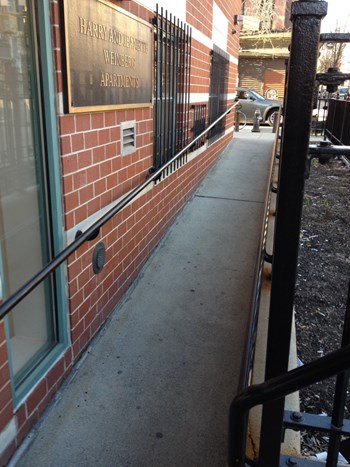
For some Chicagoans, planning daily errands and activities can be as tricky as mountaineering. These folks live with disabilities, are elderly, or for whatever reason have had their mobility compromised—even temporarily. For them, getting into or out of their own buildings can feel like a monumental task...like climbing a mountain.
Fortunately, there are laws in place intended to provide protection and help make daily life a little bit easier for those living with disabilities. Two in particular—Title III of the Americans with Disabilities Act of 1990 (ADA) and the Federal Fair Housing Amendments Act of 1988 (FHAA)—were designed to compel owners of certain buildings to ensure that people with disabilities have access equal or similar to that available to the general public.
While Title III does not apply to strictly residential facilities and multifamily buildings, it covers places of public accommodation within residential facilities. Thus, areas within multifamily residential facilities that qualify as places of public accommodation are covered by the ADA if use of the areas is not limited exclusively to owners, residents and their guests. See definitions and examples at www.ada.gov/taman3.html.
Serious Business
While legal professionals are quick to point out that the term 'disability' can refer to a very broad array of situations which may—or may not—be visible to the casual observer, one thing is certain: a building resident requesting reasonable accommodation for a disability is not something that should ever be taken lightly. 'Reasonable accommodation' under the ADA or FHAA can refer to both structural adjustments and administrative changes, such as permitting a disabled resident to have a service or companion animal despite a building's 'no pets' policy.
As with many laws however, deciphering the language of accessibility can be complicated, and misinterpretation can result in unnecessary animosity and needless expense. For example, in some cases, managers and trustees in older or historic buildings may believe—incorrectly—that they are exempt from accessibility requirements. Others may be baffled by the technical requirements of these laws, and still others are resistant to accessibility issues because they assume they automatically imply huge capital expenditures. The Illinois Accessibility Code applies to new construction and modifications to multifamily housing. However it does not apply to modifications made using private funds. See Section 400.520 at www.ada.gov/ taman3.html. In addition to the above there are also municipal codes regarding accessibility. Chicago has accessibility requirements in Chapter 18-11 of its Municipal Code.
Of all these concerns, the biggest question that many have is how far their building or HOA must to go provide 'reasonable' accommodations. “Unfortunately, there are no bright-line tests to establish 'reasonableness,'” says Massachusetts-based attorney Joseph Saurino. “Rather, the balancing test typically boils down to weighing the costs and other hardships to the association in meeting the request against the requesting resident’s need for the accommodation in order to use and enjoy the condominium.”
The statute itself is broad and because the accessibility guidelines provide a lot of specifics, it must be reviewed very carefully. And although the guidelines are in place to insure accessibility, that doesn't necessarily mean that a building must undertake massive renovations to address every situation named in the statute.
According to Mark Furlane, an attorney associated with the Chicago-based Center for Disability & Elder Law, “If a multi-unit building meets the guidelines, but the occupant wants to modify a unit or space to remove a barrier or otherwise make it more accessible to the disabled individual, then the association does not have to make the modification but must permit reasonable modifications by the occupant, at the occupant's expense.”
“In one of our buildings, we have a disabled resident who used money he'd gotten from the federal government to pay for retrofitting and motorizing doors and so forth,” says Keith Hales, president of Chicago-based Hales Property Management. “His accommodations were for his benefit,” so it was determined that the building itself was not obligated to pay for the adjustments.
That being said, legal pros are quick to point out how important it is to remember that state and local laws vary, and may result in different answers to specific accommodation requests. For that reason, an association should always consult with their local counsel or a knowledgeable architect when it comes to issues of access and accommodation. “There may be a dispute over whether the modification requested is reasonable, which is addressed on a case-by-case basis, looking to whether it would cause an undue burden on the other owners/occupiers,” says Furlane.
Other Considerations
According to Hales, it's also important that boards know the limits of their own jurisdiction when it comes to negotiating accommodations for disabled residents. He stresses the importance of striking a balance between being proactive and respecting residents' privacy, and says that he wouldn’t explicitly ask a resident if they needed special assistance, he would make absolutely certain that residents know their building manager and board are available and committed to hearing and addressing their needs.
“You don’t want to step on someone’s privacy,” Hales says, “but if you need us, you can always call us. In a condo, the philosophy is that you need to stand up for yourself.” He goes on to say that under the Federal Fair Housing Act, it is usually unlawful to ask if an applicant has a disability, or if a person intending to reside in a dwelling (or anyone associated with that person) has a disability, or ask about the nature or severity of such persons' disabilities.
For example, say you offer accessible units to persons with disabilities; you can ask if they have a disability because you want to see if they can use the features of the unit. However, you may not ask if they have other types of physical or mental impairments. “We’re not going to knock on doors and ask questions,” says Hales, “but if something is brought to our attention, we’ll address it by contacting our legal team and the board to come up with a clear plan or protocol.”
Compliance 101
In spite of the fact that there are specific federal and state laws on disabled access, some managers and building owners drag their feet when it comes to making required alterations for disabled residents. “Sometimes a board or management company will deny a request for a reasonable accommodation simply because they do not know the law,” says Lisa Bragança, legal director for the advocacy group Access Living of Metropolitan Chicago. “These are the situations that can end up in protracted litigation or create bad feeling among residents.”
According to the pros, a first violation of the federal Fair Housing Amendments Act may result in a fine of up to $11,000, and subsequent violations may result in fines ranging between $27,500 and $55,000 under the federal statute—not including a claimant’s actual damages. Violations of Illinois’ anti-discrimination laws may also result in similarly harsh consequences—or even worse. Reported settlements in these types of cases have run into the hundreds of thousands of dollars.
In the rare event that a request continues to be refused, the case may be sent to the Department of Justice (DOJ), which relies on a group known as the Key Bridge Foundation to mediate a solution. The foundation is a non-profit organization underwritten by the DOJ and organized to handle complaints filed with the DOJ under Title III of the ADA.
Good Neighbors
One point the pros stress when it comes to equal access is that it's important to remember that accommodations and compliance don't always have to involve high-tech equipment or great expense—sometimes common sense and a neighborly spirit go a long way.
According to Bragança, “Proactive condo and homeowner boards could implement annual training on the Fair Housing laws...to ensure that residents and management understand their rights and obligations, and could adopt a policy informing residents how to make a request for a reasonable accommodation, and provide examples of some of the more common accommodations requested.”
The Institute for Human Centered Design in Boston produces an ADA Checklist for buildings that includes concrete, yes/no questions for building owners and administrators about their property's compliance, as well as simple solutions to correct noncompliance. For example, “If the main entrance is not accessible, is there an alternative accessible entrance? Do all inaccessible entrances have signs indicating the location of the nearest accessible entrance?” If not, the checklist advises building administrators to “install signs on route before people get to inaccessible entrances so [they] do not have to turn around and retrace their route.”
As more Baby-Boomers age and require accommodations in order to enjoy their homes and common areas, the demand for accessible housing will increase—and ADA-compliant features can be used as strong marketing tools to a 55-and-over population, says Bragança. “There are tremendous benefits to being a fully accessible building. Prospective homebuyers are becoming more knowledgeable about the advantages of purchasing fully accessible housing. They understand that purchasing such a unit means that they will not risk having to move in the event that a member of the household acquires a disability that makes the building or unit inaccessible. Moreover, they understand that family members and friends who have disabilities will be able to visit their home for holidays and other social occasions.”
Many developers and building managers understand that it's in their own best interest to provide accommodations for disabled unit owners. In doing so, they not only raise the sense of community in their buildings but also let all residents know that they’re valued—regardless of their mobility.
J.M. Wilson is a freelance writer and a frequent contributor to The Chicagoland Cooperator. Associate Editor Hannah Fons contributed to this article.






Leave a Comment